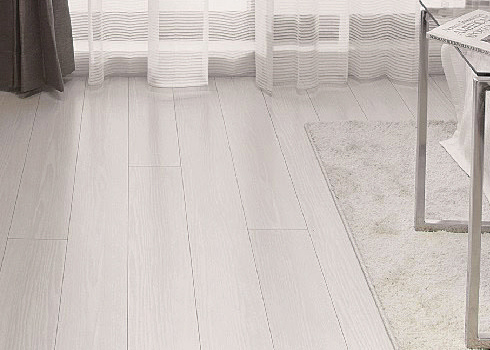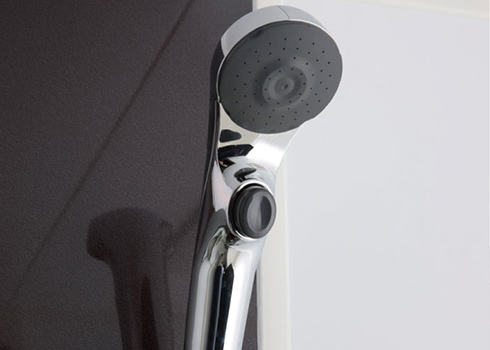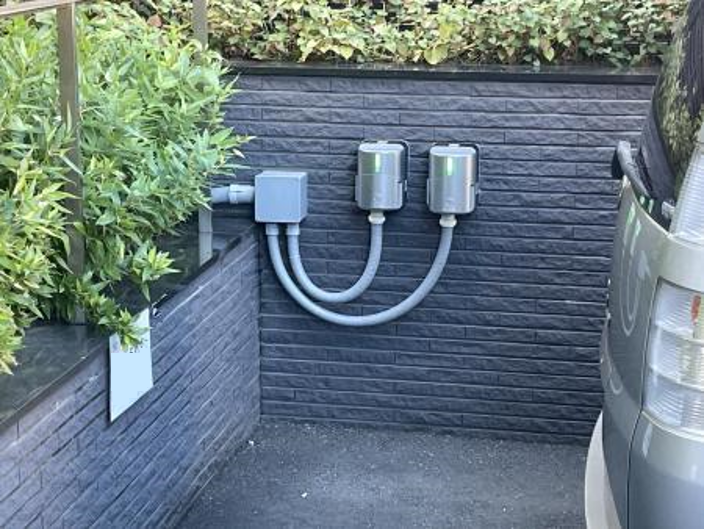Social and Environmental Initiatives of the FJ Next Group
Adoption of environmentally-friendly materials and fixtures

LED lighting used in common areas (partial) and private areas
LED lighting is used for part of the common area and all lighting in the private area. Energy saving equipment with low power consumption (about 85% reduction of incandescent bulb) and long life (more than about 20 times that of incandescent bulb).
In addition, the ceiling light of the exclusive part has a dimming function as a standard specification, so you can use it while conscious of saving yourself.

Eco-friendly plywood used for flooring
We use environmentally-friendly wood flooring, such as plywood made from planted trees, and sustainable (sustainable) wood that effectively uses the sawn wood from sawn timber and domestic thinned wood. (Excluding some)

Low formaldehyde specification
As a measure against sick houses, we use “F ☆☆☆☆” with low formaldehyde emission for interior materials.

Water-saving combination faucet and shower head with one-click stop
The Company uses an environmentally-friendly and water-saving combination faucet with a single-lever design, and a water-saving shower head with a stop button which users push by hand in order to avoid wasting water.

Air conditioners that comply with energy-saving rules are standard equipment
*Limited to units equipped with air conditioners.

Use of a water-saving toilet series
The Company uses a water-saving toilet series that achieves a significant increase in water-saving efficiency when compared to conventional products.
Introducing EV charging services
The Gala Condominium series is gradually introducing and installing electric vehicle charging service equipment to promote the reduction of carbon dioxide (CO2) emissions.



Introducing an electric kickboard services “LUUP”
The Gala Condominium series is promoting the installation of the electric kickboard 'LUUP', which is a next-generation mobility infrastructure that takes the environment into consideration.



Greening efforts
The Gala Condominium series promotes rooftop greening as a part of measures against the heat island phenomenon.



Environmental conservation activities
Support for decarbonization efforts and “Deco-katsu”
- The Group supports "Deco-katsu" a new national movement promoted by the Ministry of the Environment to achieve decarbonization, and is carrying out the following eco-activities within the company.
- Cool Biz and Warm Biz (Introduction of business casual)
- Switching to LED for office lighting
- Recycling used clear holders
- Effective use of vinyl umbrellas (sharing unused spare umbrellas within the Company)

Participation in “BRING UNIFORM™”
We sympathize with the concept of “BRING UNIFORM™” for the realization of a sound material-cycle society, and are participating in efforts to eliminate the disposal of corporate uniforms.
The Group promotes the recycling of uniforms worn by patrol employees, life managers (condominium managers), and clean staff engaged in condominium management operations for the purpose of reducing CO2 emissions.

Intoroducing an e-commerce site “CLOSED Mart”
We have introduced the e-commerce site 'CLOSED Mart,' which deals with food and products that are difficult to distribute in the general market, and we are working on reducing waste loss and supporting developing countries.
Support for environmental conservation activities of Akagi Nature Park

We support environmental preservation of Akagi Nature Park, a vast forest of about 12.8 million square feet at the western base of Mt. Akagi in Gunma prefecture. For nearly 30 years, under the policy of "instead of growing flowers ourselves, we develop the proper environment to foster their natural growth," the park has been improving the environment of the original forests and thickets. Today, the park is full of natural flowers, trees, insects, animals, and precious plants. Visitors can experience the beauty of Japan's four seasons. Species of flora and fauna found in the garden: 1,810 insects, 77 birds, 15 mammals, 152 tree species, 510 plant species

Afforestation activities
The Company is an official supporter of Green Site License.
We are planting trees in developing countries (in Africa and Asia) through Green Site License.

Information Disclosure Based on TCFD RecommendationsTask Force on Climate-Related Financial Disclosures
The FJ Next Group recognizes that climate change is a significant management issue that will affect business continuity, and is working to analyze and evaluate the financial impact of climate change-related risks and opportunities on our core businesses.
Our Risk Compliance Committee will analyze and evaluate risks and opportunities, including those related to the climate and other environmental factors, and consider countermeasures. Board Directors will receive reports from the Risk Compliance Committee as appropriate, consider and resolve countermeasures as necessary, and monitor the progress of countermeasures.

We regard "climate-related risks" as one type of medium- to long-term risk, and in order to consider strategies and organizational resilience that take into account related risks and opportunities, we referred to climate change scenarios (1.5°C scenario and 4°C scenario) set out by the IEA (International Energy Agency) and the IPCC (Intergovernmental Panel on Climate Change), considered the impact on our company up to 2030, and conducted a scenario analysis on our group's mainstay real estate development business.
- We conducted a quantitative analysis of the transition risks of the 1.5°C scenario and estimated the impact on our consolidated financial figures.
(※1.5℃ scenario: A scenario in which measures such as strengthened regulations and market changes are taken to limit the rise in temperature to 1.5℃ by the end of this century.)
(※4°C scenario: A scenario in which rising temperatures result in physical impacts such as abnormal weather.)
Going forward, we will continue to consider countermeasures focusing on risks and opportunities that have a large impact on our business, and by linking these with our business strategies as necessary, we will strive to improve our resilience and contribute to the realization of a decarbonized society.
The Risk Compliance Committee will identify and evaluate climate-related risks through scenario analysis. The risk management process involves identifying climate-related risks related to our Group's business, assessing the impact of the risks based on the likelihood of occurrence and the magnitude of their impact, and, if necessary, analyzing the financial impact and considering countermeasures. If there is a possibility of a climate-related risk with a large impact occurring, the Risk Compliance Committee will develop countermeasures and the Chairman will report them to the Executive Committee or Board Directors, which will then comprehensively deliberate and make a decision at the Board of Directors.
In order to evaluate and manage the impact of climate change issues on our business, the Group has set total greenhouse gas (CO2) emissions (Scope 1 and 2) as an indicator.
| Scope1 | Scope2(Market Standards) | Scope 1 and 2 total |
|---|---|---|
| 552.96 t-CO2 | 805.39 t-CO2 | 1,358.35 t-CO2 |
※Estimation subjects: All group companies
We are promoting efforts to reduce greenhouse gas emissions and are considering reduction targets.
| Section | Classification | Item | Impact details | Impact | Our company measures |
|---|---|---|---|---|---|
| Transition risks (1.5℃ scenario) | Policies/Regulations | Introducing carbon pricing | Increase in construction costs for new condominiums and decrease in consolidated operating profit | ○Consult with design and construction companies regarding future research and support for recycled materials and low-carbon materials (such as low-carbon concrete) | |
| Products/Services | Strengthening energy conservation regulations | Increased costs to meet improved environmental performance | ○High added value through improved environmental performance | ||
| Policies/Regulations | Introduction of carbon pricing (carbon tax, etc.) | Increased costs for our own use | ○Measures for our own office (rented) A. Promoting energy conservation activities (power saving and updating to high-energy-efficiency equipment) B. Switching to a renewable energy electricity menu |
||
| Physical risks (4°C scenario) | Radical | Wind and flood damage to construction sites | Damage to construction sites caused by river and coastal flooding, resulting in work delays and increased construction costs | ○Promoting countermeasures together with construction companies A. Developing disaster prevention/mitigation and BCP-related technologies B. Developing and utilizing hazard maps with added knowledge C. Obtaining pinpoint weather information D. Encouraging "construction work insurance," "civil engineering work insurance," "assembly insurance," etc. according to the content of the work E. Calling for the formulation of disaster prevention plans, including flood prevention measures, before construction begins |
|
| Radical | Damage caused by natural disasters at construction material suppliers | Suspension of operations and increased construction costs due to damage to suppliers | ○Together with construction companies, we are building a BCP system integrated with the supply chain and conducting regular training. | ||
| Chronic | Rising temperatures will increase construction costs | Lower productivity and higher construction costs | ○Further promote labor-saving and mechanization of construction work (Consult with construction companies) - Promote PC construction methods, mechanize construction work, share information remotely |
||
| Radical | Accelerating deterioration due to rising temperatures | Increased inspection and repair costs for rental apartments owned by our company - Increased breakdowns of air conditioning equipment, earlier peeling of paint, and corrosion of building structures - Damage to buildings due to wind and flood damage |
A. By constructing buildings using long-life construction methods, inspection and repair costs can be reduced. - Uses highly durable wall materials, etc. - Adopts highly durable buildings and air conditioning equipment, etc. B. Overall cost reduction by increasing inspection frequency and repairs based on inspection results |
||
| Chronic | Increased air conditioning equipment in owned rental properties due to rising annual temperatures | Increased costs for air conditioning equipment (initial investment amount/replacement costs, maintenance costs, air conditioning costs) |
○By improving the environmental performance of the property as mentioned above, the operation of air conditioning equipment is reduced. | ||
| Opportunity | Reputation | Increased investor appreciation for decarbonization efforts | Positive impact of promoting decarbonization efforts on fundraising | A. Promoting the development of condominiums with improved environmental performance B. Promoting disclosure of decarbonization efforts |
|
| Market | Increase in demand for condominiums with enhanced environmental performance | Increased sales due to condominiums with enhanced environmental performance | ○Capture demand by promoting the development of condominiums with improved environmental performance in the future |
